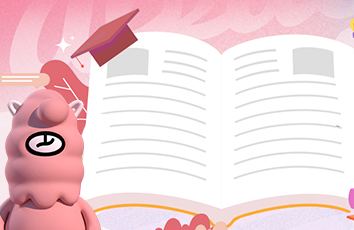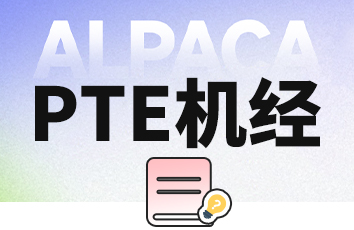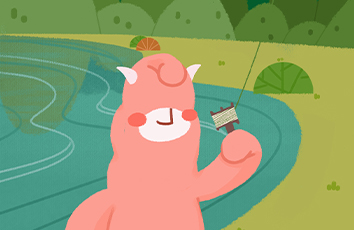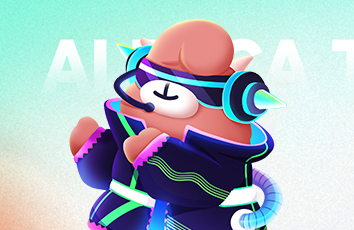PTE写作SWT题型有哪些解题方法
各位正在备考PTE考试的同学们,今天羊驼给大家带来的是老师讲解的PTE写作SWT题型的例题:Rosetta Stone,罗塞塔石碑,这道题从难度上而言,要看懂这篇文章挺难的,原因是它用了很多不太常见的词汇。但是当你把这篇文章的意思全部弄懂之后,会发现相对来说还是蛮简单的。
一、PTE写作SWT例题的原文:
When the Rosetta Stone was discovered in 1799, the carved characters that covered its surface were quickly copied. Printer's ink was applied to the Stone and white paper laid over it. When the paper was removed, it revealed an exact copy of the text-but in reverse. Since then, many copies or "facsimiles" have been made using a variety of materials. Inevitably, the surface of the Stone accumulated many layers of material left over from these activities, despite attempts to remove any residue. Once on display, the grease from many thousands of human hands eager to touch the Stone added to the problem.An opportunity for investigation and cleaning the Rosetta Stone arose when this famous object was made the centerpiece of the Cracking Codes exhibition at The British Museum in 1999. When work commenced to remove all but the original, ancient material, the stone was black with white lettering. As treatment progressed, the different substances uncovered were analyzed. Grease from human handling, a coating of carnauba wax from the early 1800s and printers ink from 1799 were cleaned away using cotton wool swabs and liniment of soap, white spirit, acetone and purified water. Finally, white paint in the text, applied in 1981, which had been left in place until now as a protective coating, was removed with cotton swabs and purified water. A small square at the bottom left corner of the face of the Stone was left untouched to show the darkened wax and the white infill.
二、PTE写作SWT例题的答案:
When the Rosetta Stone was discovered in 1799, the carved characters that covered its surface were quickly copied, and the surface of the Stone accumulated many layers of material left over from these activities, despite attempts to remove any residue, but an opportunity for investigation and cleaning the Rosetta Stone arose when this famous object was made the centerpiece of the Cracking Codes exhibition, which shows that the stone was black with white lettering. (74 words)
三、PTE写作SWT例题的翻译:
When the Rosetta Stone was discovered in 1799, the carved characters that covered its surface were quickly copied.
当罗塞塔石碑在1799年被发现时,覆盖在石碑表面的刻字很快就被复制了。
Printer's ink was applied to the Stone and white paper laid over it.
打印机的墨水被涂在石头上,白纸盖在上面。
When the paper was removed, it revealed an exact copy of the text-but in reverse.
当这张纸被移开时,露出了一份完全相同的文本——只不过是反过来的。
Since then, many copies or "facsimiles" have been made using a variety of materials.
从那时起,使用各种材料制作了许多副本或“摹本”。
Inevitably, the surface of the Stone accumulated many layers of material left over from these activities, despite attempts to remove any residue.
不可避免地,石头的表面积累了许多层这些活动留下的物质,尽管试图清除任何残留物。
Once on display, the grease from many thousands of human hands eager to touch the Stone added to the problem.
一旦展出,成千上万渴望触摸宝石的人们手上的油脂又加剧了这个问题。
An opportunity for investigation and cleaning the Rosetta Stone arose when this famous object was made the centerpiece of the Cracking Codes exhibition at The British Museum in 1999.
1999年,当这个著名的物品成为大英博物馆破解密码展览的中心展品时,人们有机会对罗塞塔石碑进行调查和清理。
When work commenced to remove all but the original, ancient material, the stone was black with white lettering.
当工作开始移除除了原始的,古老的材料,石头是黑色和白色的刻字。
As treatment progressed, the different substances uncovered were analyzed.
随着处理的进行,对发现的不同物质进行分析。
Grease from human handling, a coating of carnauba wax from the early 1800s and printers ink from 1799 were cleaned away using cotton wool swabs and liniment of soap, white spirit, acetone and purified water.
人类接触产生的油脂、19世纪早期的巴西棕榈蜡涂层和1799年的打印机墨水,都是用棉签和肥皂、白酒、丙酮和纯净水擦去的。
Finally, white paint in the text, applied in 1981, which had been left in place until now as a protective coating, was removed with cotton swabs and purified water.
最后,在1981年使用的白色涂料,一直作为保护涂层保留至今,用棉签和纯净水去除。
A small square at the bottom left corner of the face of the Stone was left untouched to show the darkened wax and the white infill.
石面左下角的一个小正方形没有动,露出了深色的蜡和白色的填充物。
四、PTE写作SWT例题的解析:
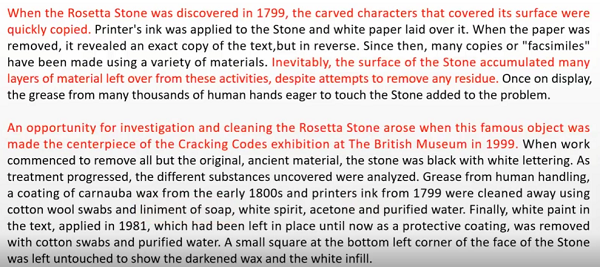
1、当罗瑟塔的石碑于11799年发现的时候,The carved characters,已经雕好了这些文字,quickly copypied,快速被复制下来。大家非常想看一看古人所写的文字是什么样的,怎么复制呢?The printerers ink was applied,运用到这个石头上面,把墨汁洒在这个石头上,然后把白纸覆盖,那么当这个白纸拿起来的时候,就可以更清楚的看到这个copy副本。但它是相反的,其整个石碑的表面,覆盖出很多乱七八糟的东西,尽管很多人尝试去移除这些污渍,但依旧还是在上面的。Once's on display,一旦展出来,就有很多成千上万的手eager to touch,很想去碰一碰这个古石头,To add to the problem,手上有很多细菌、油脂,这种古迹最好是好好的保存一下。
2、Opportunity,一种机会就应运而生,去调查、研究、清洗罗斯塔stone,就已经出现了。当这个非常著名的东西被展出来在大英博物馆,1999年这样一个啊碎石裂石的这种展览馆上面,被放在一个centerpiece,大家觉得有必要去好好研究这个石头,并且把它清理干净。我们发现一些很脏的污渍怎么清洗?比方说它用了一些purified water纯净水,包括棉签、酒精、乙丙酮化学物质,你不用看懂,这肯定是一种方法。我们发现当时他们使用了一种油漆,作为一种保护涂层盖在上面,最后也被清理干净了,使用的是纯净水、棉签。一些暗沉的蜡,还有一些白色的填充物还是遗留在那里。
3、这讲的还是蛮详细的,而且使用的单词都比较难,但事实上我们要去做这道题的一个summary,一个总结的话,其实还是比较简单的。首先介绍罗塞塔的这个石头,其次告诉大家为什么要讲的原因。

